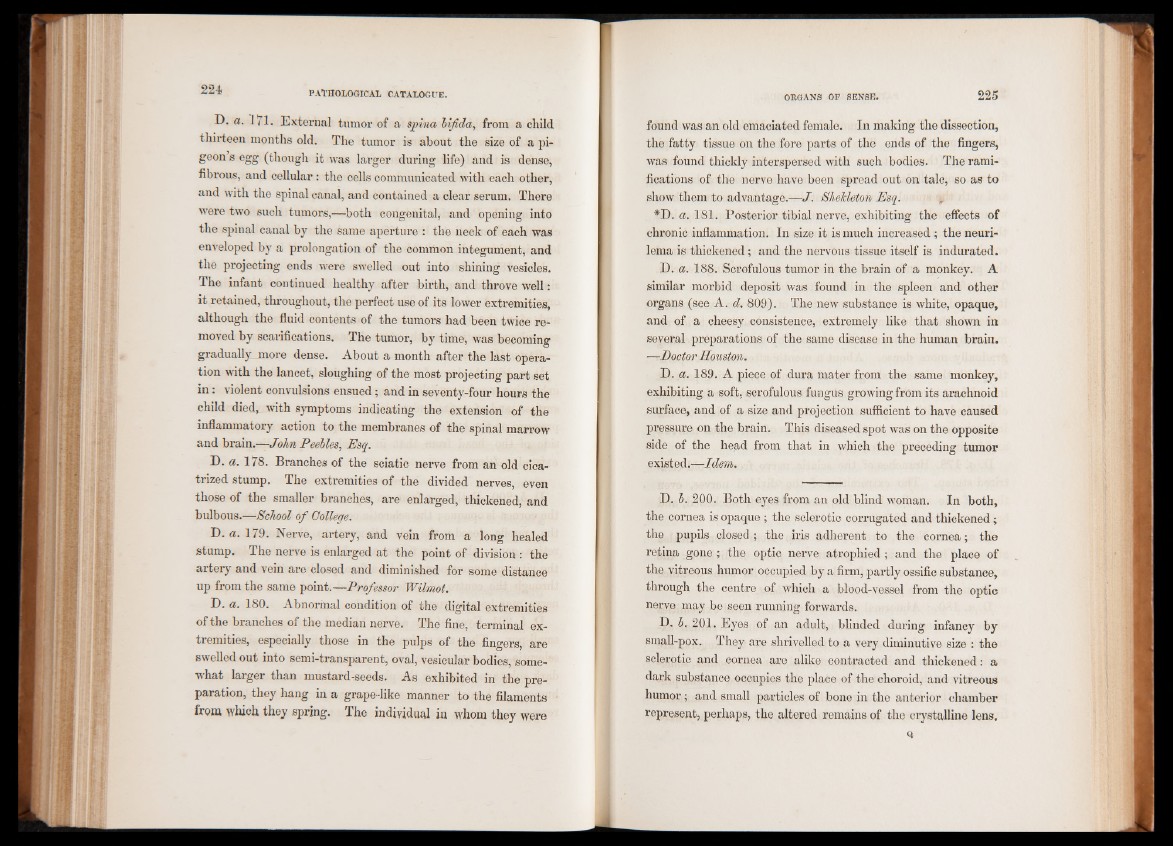
D. a. 171. External tumor of a spina bifida, from a child
thirteen months old. The tumor is about the size of a pigeon
s egg (though it was larger during life) and is dense,
fibrous, and cellular : the cells communicated with each other,
and with the spinal canal, and contained a clear serum. There
were two such tumors,—both congenital, and opening into
the spinal canal by the same aperture : the neck of each was
enveloped by a prolongation of the common integument, and
the projecting ends were swelled out into shining vesicles.
The infant continued healthy after birth, and throve well:
it retained, throughout, the perfect use of its lower extremities,
although the fluid contents of the tumors had been twice removed
by scarifications. The tumor, by time, was becoming
gradually more dense. About a month after the last operation
with the lancet, sloughing of the most projecting part set
in: violent convulsions ensued; and in seventy-four hours the
child died, with symptoms indicating the extension of the
inflammatory action to the membranes of the spinal marrow
and brain.—John Peebles, Esq.
D. a. 178. Branches of the sciatic nerve from an old cicatrized
stump. The extremities of the divided nerves, even
those of the smaller branches, are enlarged, thickened, and
bulbous.—School of College.
D. a. 179. Nerve, artery, and vein from a long healed
stump. The nerve is enlarged at the point of division : the
artery and vein are closed and diminished for some distance
up from the same point.—Professor Wilmot.
D. a. 180. Abnormal condition of the digital extremities
of the branches of the median nerve. The fine, terminal extremities,
especially those in the pulps of the fingers, are
swelled out into semi-transparent, oval, vesicular bodies, somewhat
larger than mustard-seeds. As exhibited in the preparation,
they hang in a grape-like manner to the filaments
from which they spring. The individual in whom they were
found was an old emaciated female. In making the dissection,
the fatty tissue on the fore parts of the ends of the fingers,
was found thickly interspersed with such bodies. The ramifications
of the nerve have been spread out on talc, so as to
show them to advantage.—J. Shekleton Esq.
*D. a. 181. Posterior tibial nerve, exhibiting the effects of
chronic inflammation. In size it is much increased ; the neuri-
lema is thickened; and the nervous tissue itself is indurated.
D. a. 188. Scrofulous tumor in the brain of a monkey. A
similar morbid deposit was found in the spleen and other
organs (see A. d. 809). The new substance is white, opaque,
and of a cheesy consistence, extremely like that shown in
several preparations of the same disease in the human brain.
—Doctor Houston.
D. a. 189. A piece of dura mater from the same monkey,
exhibiting a soft, scrofulous fungus growing from its arachnoid
surface, and of a size and projection sufficient to have caused
pressure on the brain. This diseased spot was on the opposite
side of the head from that in which the preceding tumor
existed.—Idem.
D. b. 200. Both eyes from an old blind woman. In both,
the cornea is opaque ; the sclerotic corrugated and thickened;
the pupils closed ; the iris adherent to the cornea; the
retina gone ; the optic nerve atrophied; and the place of
the vitreous humor occupied by a firm, partly ossific substance,
through the centre of which a blood-vessel from the optic
nerve may be seen running forwards.
D. b. 201. Eyes of an adult, blinded during infancy by
small-pox. They are shrivelled to a very diminutive size : the
sclerotic and cornea are alike contracted and thickened: a
dark substance occupies the place of the choroid, and vitreous
humor; and small particles of bone in the anterior chamber
represent, perhaps, the altered remains of the crystalline lens.
Q